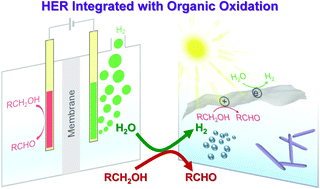Electrocatalytic and photocatalytic hydrogen evolution integrated with organic oxidation
Abstract
Renewable energy-driven hydrogen production from electrocatalytic and photocatalytic water splitting has been widely recognized as a promising approach to utilize green energy resources and hence reduces our dependence on legacy fossil fuels as well as alleviates net carbon dioxide emissions. The realization of large-scale water splitting, however, is mainly impeded by its slow kinetics, particularly because of its sluggish anodic half reaction, the oxygen evolution reaction (OER), whose product O2 is ironically not of high value. In fact, the co-production of H2 and O2 in conventional water electrolysis may result in the formation of explosive H2/O2 gas mixtures due to gas crossover and reactive oxygen species (ROS); both pose safety concerns and shorten the lifetimes of water splitting cells. With these considerations in mind, replacing the OER with thermodynamically more favorable organic oxidation reactions is much more preferred, which will not only substantially reduce the voltage input for H2 evolution from water and avoid the generation of H2/O2 gas mixtures and ROS, but also possibly lead to the co-production of value-added organic products on the anode. Indeed, such an innovative strategy for H2 production integrated with valuable organic oxidation has attracted increasing attention in both electrocatalysis and photocatalysis. This feature article showcases the most recent examples along this endeavor. As exemplified in the main text, the oxidative transformation of a variety of organic substrates, including alcohols, ammonia, urea, hydrazine, and biomass-derived intermediate chemicals, can be integrated with energy-efficient H2 evolution. We specifically highlight the importance of oxidative biomass valorization coupled with H2 production, as biomass is the only green carbon source whose scale is comparable to fossil fuels. Finally, the remaining challenges and future opportunities are also discussed.



 Please wait while we load your content...
Please wait while we load your content...
